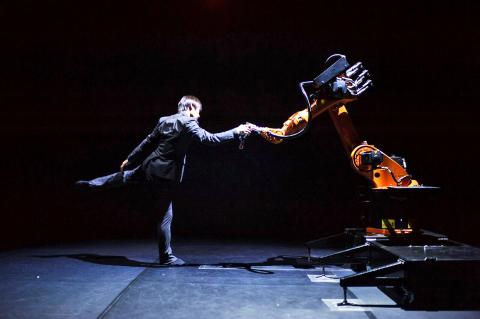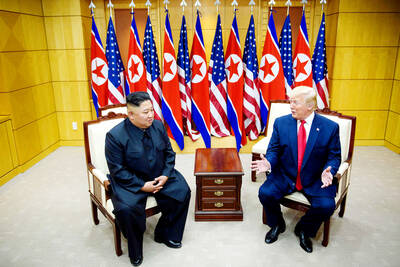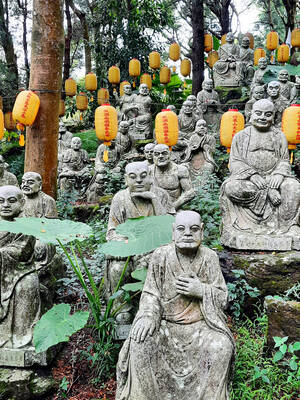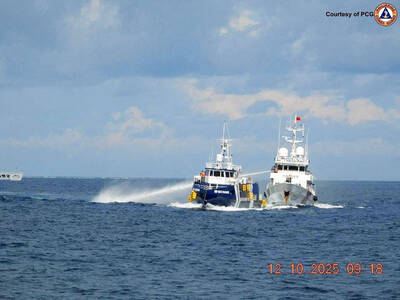The ballet world has long had stories about puppets and dolls that come to life, from the life-sized Coppelia created by Dr Coppelius to Drosselmeyer’s Nutcracker, both of which were inspired by stories from the German writer E. T. A. Hoffmann. So it seems somewhat fitting that there is a German connection to the dances of a modern-day Coppelius, Taiwanese dancer/choreographer Huang Yi (黃翊), who uses a robot produced by Ausberg-based KUKA AG.
His company, Huang Yi Studio +, gave four performances of the enchanting 70-minute Huang Yi & KUKA (黃翊與庫卡) at the Cloud Gate Theater in New Taipei City’s Tamsui District (淡水) over the weekend.
Saturday night’s show demonstrated how Huang has managed to blur the boundaries between magic and technology, human and non-human, as I found myself anthropomorphizing the robot in my notes, with references to its gracefulness, tenderness, playfulness and inquisitiveness. Of course, that KUKA displays any of those traits is down to Huang’s computer programming and choreography, but it was hard not to see KUKA as a separate entity on stage.

Photo courtesy of Jacob Blinkenstaff
The storyline of the show involves Huang, initially in a rectangle of light akin to the metal base that KUKA rests upon, first reaching out to KUKA and using the robot as a partner — balancing in an arabesque with his hand on KUKA’s outstretched arm — then having KUKA explore the stage and itself, before KUKA begins to respond independently, until by the end, KUKA becomes the choreographer, using a laser beam to manipulate two dancers (Hu Chien, 胡鑑 and Lin Jou-wen, 林柔雯) who are seated in chairs before it.
Huang heightened the techno/mechanical feel to the performance by stripping all the curtains from the Cloud Gate Theater stage, front and side, to widen the stage space, and then using a staggered arrangement of empty light batons as a front curtain. As the audience entered the theater, KUKA could be dimly seen standing on the dark stage, waiting for Huang’s magic touch to bring it alive. As the final warning gong rang before the show, the batons began silently moving slowly, up and down, up and down, creating the feeling of being inside a mechanical works.
The audience’s reactions during Huang Yi & KUKA were interesting, with Huang and KUKA receiving a rousing round of applause after the opening segment, while the following segment with KUKA performing alone was greeted with silence. When Huang later attached a videocamera to KUKA’s arm, allowing KUKA to “explore” its space, with the black-and-white video projected onto the backdrop, several people were unable to resist waving as the camera swept the audience — were they saying hello to the robot, or was it that they could not resist the chance to mark their spot, even though no one outside the theater would see the video?
Earlier in the day at the Experimental Theater in Taipei, dancer/choreographer Luo Wen-jinn (羅文瑾) gave a glimpse into humanity’s psyche, which proved both entertaining and a little bit disturbing.
Dripping (詭‧跡), by the Scarecrow Contemporary Dance Company (稻草人現代舞蹈團), featured just Luo and Li Pei-shan (李佩珊), yet they proved more than able to hold the audience’s attention.
The piece began with Li doing a series of isolationist upper body moves as she slowly made her way from one rectangle of light to another along the back wall and then on a diagonal across the stage. On a second go round, she picked up speed and added another diagonal cross, which ended when she encountered a bucket on a chair, into which she promptly placed her head and then sat down. Meanwhile, Luo was slowly moving along the floor next to the left wall, with her head and shoulders trapped under a larger bucket, until she was able to break free of the wall and move to the center of the floor.
The pair spent the majority the piece trapped in their individual worlds, though facing the same problems of buckets and water dripping from the mesh lighting grid below the ceiling. Even when there was not water actually dropping, the musicians — Misa Wen (米莎) on piano/organ and vocalizations, Monlieng Lee (孟濂) on an upright bass and percussionist Tsai Yi-cheng Tsai (蔡易成) — on the right-hand side of the stage provided the sounds of drips, heightening the sense of unreality.
There was one segment in which Luo and Li did actually dance together — a duet of parallel movements carried out a few meters apart — to Sheldon Brooks’ Some of These Days.
Otherwise they were on their own in a world awash with scores of buckets, mysterious trench-coated figures with buckets for heads that glided across the floor, and a heaving mass of crumpled, ruched jersey that at first looked like a benign flower— until it began to heave and move, revealing itself to be a brain with a head and fingers struggling to emerge from an opening at one end.
As much as I loved the show, I found myself cringing at the thought that Luo might join forces one day with Craig Quintero, the director of Riverbed Theater (河床劇團), whose surrealistic productions often possess a similar nightmarish quality. Such a joint venture would certainly ensure sleepless nights for many viewers.
I also made a note never to read Jean-Paul Sartre, whose novel Nausea was the inspiration for Dripping, before bedtime.

US President Donald Trump may have hoped for an impromptu talk with his old friend Kim Jong-un during a recent trip to Asia, but analysts say the increasingly emboldened North Korean despot had few good reasons to join the photo-op. Trump sent repeated overtures to Kim during his barnstorming tour of Asia, saying he was “100 percent” open to a meeting and even bucking decades of US policy by conceding that North Korea was “sort of a nuclear power.” But Pyongyang kept mum on the invitation, instead firing off missiles and sending its foreign minister to Russia and Belarus, with whom it

When Taiwan was battered by storms this summer, the only crumb of comfort I could take was knowing that some advice I’d drafted several weeks earlier had been correct. Regarding the Southern Cross-Island Highway (南橫公路), a spectacular high-elevation route connecting Taiwan’s southwest with the country’s southeast, I’d written: “The precarious existence of this road cannot be overstated; those hoping to drive or ride all the way across should have a backup plan.” As this article was going to press, the middle section of the highway, between Meishankou (梅山口) in Kaohsiung and Siangyang (向陽) in Taitung County, was still closed to outsiders

Many people noticed the flood of pro-China propaganda across a number of venues in recent weeks that looks like a coordinated assault on US Taiwan policy. It does look like an effort intended to influence the US before the meeting between US President Donald Trump and Chinese dictator Xi Jinping (習近平) over the weekend. Jennifer Kavanagh’s piece in the New York Times in September appears to be the opening strike of the current campaign. She followed up last week in the Lowy Interpreter, blaming the US for causing the PRC to escalate in the Philippines and Taiwan, saying that as

The Chinese Communist Party (CCP) has a dystopian, radical and dangerous conception of itself. Few are aware of this very fundamental difference between how they view power and how the rest of the world does. Even those of us who have lived in China sometimes fall back into the trap of viewing it through the lens of the power relationships common throughout the rest of the world, instead of understanding the CCP as it conceives of itself. Broadly speaking, the concepts of the people, race, culture, civilization, nation, government and religion are separate, though often overlapping and intertwined. A government